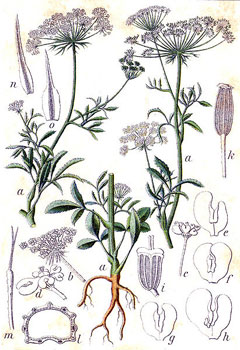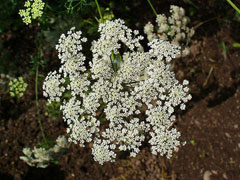 |
|
http://commons.wikimedia.org/wiki/File:Ammi_majus_Sturm8.jpg |
 |
| http://commons.wikimedia.org/wiki/File:Ammi_majus_002.JPG |
Translate this page:
Summary
Bloom Color: White.
Main Bloom Time: Early summer, Late summer, Mid summer. Form: Irregular or sprawling, Upright or erect.
Physical Characteristics

 Ammi majus is a ANNUAL growing to 0.8 m (2ft 7in) by 0.4 m (1ft 4in) at a medium rate. It is in flower from June to October, and the seeds ripen from July to October. The species is hermaphrodite (has both male and female organs) and is pollinated by Insects. The plant is self-fertile.
Ammi majus is a ANNUAL growing to 0.8 m (2ft 7in) by 0.4 m (1ft 4in) at a medium rate. It is in flower from June to October, and the seeds ripen from July to October. The species is hermaphrodite (has both male and female organs) and is pollinated by Insects. The plant is self-fertile.
Suitable for: light (sandy), medium (loamy) and heavy (clay) soils. Suitable pH: mildly acid, neutral and basic (mildly alkaline) soils. It can grow in semi-shade (light woodland) or no shade. It prefers moist soil.
UK Hardiness Map
US Hardiness Map
Synonyms
Plant Habitats
Cultivated Beds;
Edible Uses
Edible Parts:
Edible Uses: Condiment
Seed - used as a condiment[177, 183].
References More on Edible Uses
Medicinal Uses
Plants For A Future can not take any responsibility for any adverse effects from the use of plants. Always seek advice from a professional before using a plant medicinally.
The seed is contraceptive, diuretic and tonic[238]. An infusion is used to calm the digestive system, whilst it is also used in the treatment of asthma and angina[254]. A decoction of the ground-up seed, eaten after intercourse, appears able to prevent implantation of the fertilized ovum in the uterus[238]. This decoction is also used as a gargle in the treatment of toothache[238]. The seed contains furanocoumarins (including bergapten), which stimulate pigment production in skin that is exposed to bright sunlight[238, 254]. The plant is widely cultivated in India for these furanocoumarins which are used in the treatment of vitiligo (piebald skin) and psoriasis[238, 254].
References More on Medicinal Uses
The Bookshop: Edible Plant Books
Our Latest books on Perennial Plants For Food Forests and Permaculture Gardens in paperback or digital formats.

Edible Tropical Plants
Food Forest Plants for Hotter Conditions: 250+ Plants For Tropical Food Forests & Permaculture Gardens.
More

Edible Temperate Plants
Plants for Your Food Forest: 500 Plants for Temperate Food Forests & Permaculture Gardens.
More

More Books
PFAF have eight books available in paperback and digital formats. Browse the shop for more information.
Shop Now
Other Uses
Weather protection
The root is chewed to give protection from strong sunlight. It contains 8-methoxypsoralen which stimulates production of pigment in skin exposed to U.V. light. Caution is advised, however, since it can cause side-effects[160]. Other reports suggest that it is the seeds that are used[238, 254].
Special Uses
Scented Plants
References More on Other Uses
Cultivation details
Landscape Uses:Border, Massing, Specimen. Prefers a well-drained soil in a sunny position[238], succeeding in ordinary garden soil. This species is often cultivated for its attractive flowering stems which are often sold in markets[238]. It is cultivated in India as a medicinal herb[238]. Special Features:
Attractive foliage, Not North American native, Suitable for cut flowers.
References Carbon Farming Information and Carbon Sequestration Information
Temperature Converter
Type a value in the Celsius field to convert the value to Fahrenheit:
Fahrenheit:
The PFAF Bookshop
Plants For A Future have a number of books available in paperback and digital form. Book titles include Edible Plants, Edible Perennials, Edible Trees,Edible Shrubs, Woodland Gardening, and Temperate Food Forest Plants. Our new book is Food Forest Plants For Hotter Conditions (Tropical and Sub-Tropical).
Shop Now
Plant Propagation
Seed - sow spring or autumn in situ[238].
Other Names
If available other names are mentioned here
Native Range
TEMPERATE ASIA: Kuwait, Cyprus, Iran, Iraq, Israel, Jordan, Lebanon, Syria, Turkey, Armenia TROPICAL ASIA: Pakistan EUROPE: Ukraine, Albania, Bosnia and Herzegovina, Greece (incl. Crete), Croatia, Italy (incl. Sardinia, Sicily), Montenegro, Slovenia, Spain (incl. Baleares), France (incl. Corsica), Portugal AFRICA: Algeria, Egypt, Libya, Morocco, Tunisia, Ethiopia
Weed Potential
Right plant wrong place. We are currently updating this section.
Please note that a plant may be invasive in one area but may not in your area so it's worth checking.
Conservation Status
IUCN Red List of Threatened Plants Status :

Growth: S = slow M = medium F = fast. Soil: L = light (sandy) M = medium H = heavy (clay). pH: A = acid N = neutral B = basic (alkaline). Shade: F = full shade S = semi-shade N = no shade. Moisture: D = dry M = Moist We = wet Wa = water.
Now available:
Food Forest Plants for Mediterranean Conditions
350+ Perennial Plants For Mediterranean and Drier Food Forests and Permaculture Gardens.
[Paperback and eBook]
This is the third in Plants For A Future's series of plant guides for food forests tailored to
specific climate zones. Following volumes on temperate and tropical ecosystems, this book focuses
on species suited to Mediterranean conditions—regions with hot, dry summers and cool, wet winters,
often facing the added challenge of climate change.
Read More
Expert comment
Author
L.
Botanical References
17
Links / References
For a list of references used on this page please go here
Readers comment
| Add a comment |
|
If you have important information about this plant that may help other users please add a comment or link below. Only comments or links that are felt to be directly relevant to a plant will be included. If you think a comment/link or information contained on this page is inaccurate or misleading we would welcome your feedback at [email protected]. If you have questions about a plant please use the Forum on this website as we do not have the resources to answer questions ourselves.
* Please note: the comments by website users are not necessarily those held by PFAF and may give misleading or inaccurate information.
To leave a comment please Register or login here All comments need to be approved so will not appear immediately.
|
|